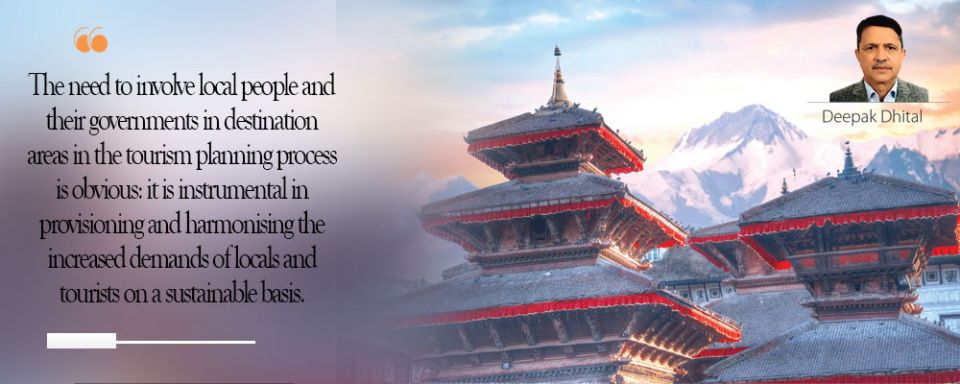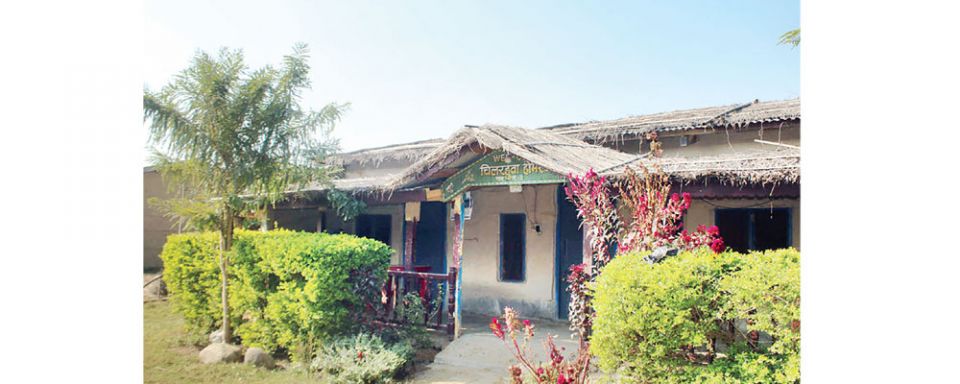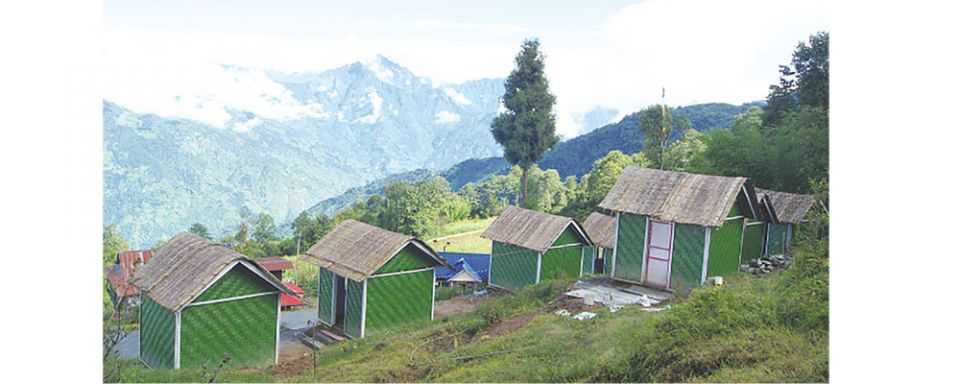
Tourist arrivals in Nepal in 2023 reached 85 per cent of the peak number achieved in pre-COVID period of 2019. This is comparable to the top trend in important global destinations, which have registered 80 to 90 per cent of the pre-COVID arrivals in the same year. However, there have been projections that the arrival trends will fully recover in the world by 2025 alone, provided there are no other disruptive exigencies. Nepal's target of two million tourists for the year 2020 suffered a debacle due to the unprecedented impact of the coronavirus pandemic. Nevertheless, the post-COVID resurgence of arrival and the abiding attractiveness of the destination itself have put us on an optimistic path. The current declaration of the tourism decade and the addition of over a hundred internal destinations on top of the traditional ones therefore constitute a natural response to tap into the vast potentiality the country holds for tourism development, diversification, and promotion. All elements of the marketing mixes of this predominantly service industry need to be given equal importance and weight throughout to achieve these and other related goals.
this turning point, a cursory look into the real prospects and existing challenges for optimising the benefits of tourism in all its aspects would be relevant. The rampart of the central Himalayas, the undulating hilly terrains, the fast-flowing rivers, the verdant valleys, and the plains of Terai, as well as the ancient monumental heritages and live cultural traditions interspersed in the incredible natural beauty, constitute the bedrock of Nepal's tourist attractions. Of paramount importance is that these top-of-the-line attributes of beauty and mysticism also constitute the goldmine of the soft power potentials of the country to keep its image high in international relations and diplomacy.

Speaking from economic perspectives, the growth of tourism is intimately associated with increasing consumer demand in the economy. The more tourists are attracted to Nepal, the more they consume in the economy in terms of available goods and services and pave the way for development and prosperity. Tourism in its ideal form is believed to stimulate a series of economic activities by setting into action a growth phenomenon famously known as ‘tourism multipliers’ in which primary demands of goods and services by tourists trigger secondary, tertiary, and other circles of demands to have positive impacts on the larger economy. It can be questioned to what extent we have been planning to reap the benefits of tourism multipliers in our unique situation.
Interestingly, tourism in Nepal stands as a cause and consequence of preserving social and cultural values and conserving the environment. Building the resilience of these entities provides sustenance for the quality of tourism. It ought to establish us in perpetual peace and harmony with our own nature, culture, and society and with the rest of the world where tourists are generated. Moreover, the message of peace, non-violence, fraternity, and love originating from the birthplace of Lord Buddha has to reach out unequivocally for the benefits of common humanity. Next come the imperatives of fostering a universal culture of safeguarding the fragile mountain ecosystem—the sheer heights with vast mazes of snow and ice, the incredible biodiversity, and the living heritages of the people—from the catastrophic consequences of climate change and environmental degradation. Clean and green tourism that can also imbibe recent advanced technology and innovation for its healthy growth and sustainability is where the focus is needed.
Challenges to overcome
A persistent challenge of modern and quality infrastructures for easier access to internal destinations of choice without any hassles is ongoing. This problem was clearly pointed out as early as 1984, when the Tourism Master Plan of 1972 was reviewed. The call for fulfilling responsibility on the part of the government in this respect got a response in the 1990s through a specific project-based approach to tourism infrastructure development in some destination areas. This specific task was, however, absorbed later into the larger national development plan, the process of which has remained sluggish and inadequate due to various reasons. World-class infrastructure with efficient outside connectivity by all possible means and modes of transport is necessary in areas that have been developing as hubs of tourism. It is perhaps necessary to declare and act upon a decade or decades of infrastructure development, keeping in mind the needs of tourism, FDI promotion, and industrialization together.

Particular attention is needed for the efficient inter- and intra-connectivity of the golden quadrilateral of mass tourism, namely Kathmandu, Pokhara, Lumbini, and Chitwan, in the first place. Other pleasure, religious, adventure, and ecotourism destinations also require a planned approach for the reason that our places are not already developed and prepared to cater to the more sophisticated tastes and preferences of tourists who are willing to pay a price for the values we create. In adventure and ecotourism destinations, well-maintained trekking trails and heritage alleyways could also deliver quality of experience, provided the aspirations of the locals and the tourists do not cross with each other. Of late, optimum utilisation of the created infrastructure, such as the two regional international airports in Pokhara and Bhairahawa, has unfortunately emerged with a management problem.
Innovative diversification of products and assurance of their qualities play a more decisive role in the pricing of the services and facilities run by the private sector. These initiatives lead to increased revenue and employment generation for the economy. The decreasing trend of average tourist expenditure, which in the government record stands at US $41 at present, is disappointing. Looking at the increased capacity of the tourism industries, the servicing needs of ecotourism and adventure destinations, and the need to share benefits with the local people for the sustainability and resilience of destinations and products, this income per tourist would prove scanty. Furthermore, how much money earned from tourism is retained in the economy and how much value addition has been achieved in the imported contents used by the industry are also crucial considerations. The paucity of data and relevant studies and reports hinders insights into this crucial aspect, though. Just for a hint, a study carried out by the Nepal Rastra Bank as early as 1989 concluded that 67.5 per cent of the income from tourism leaked out in terms of imports for the tourism industry itself and other factor and non-factor payments, and only 32.5 per cent was retained in the economy. The situation might have worsened now as the imports have been surging unabatedly. The same report also showed a negative retention rate of revenue generated by the operation of international airlines, signalling the importance of consolidating the position of national carriers in the transportation of tourists. The GDP contribution from tourism recorded in Nepal is significantly lower than the figures normally presented in our case by the World Travel and Tourism Council. It makes things rather confusing as to whether we have been making the correct analysis of the total economic impacts of tourism.
Prospects to tap on
The vast tourist-originating markets are getting closer due to the rising middle class in both India and China and increasing trends among their citizens to travel. Whereas tourists essentially meant western wanderlust travellers in the 1970s and 1980s for Nepal, our neighbours, India and China, have come up with a larger prospect as markets of tourist origin now. China has listed Nepal as a destination country. In 2019, Chinese outbound tourists reached 155 million, whereas Indian outbound tourists hit 26.92 million. Interestingly, 677 million domestic tourists travelled inside India in 2017. Given the open border and common culture, and the call of outstanding beauty in nature, culture, and adventure as opportunities waiting here, a part of that tourist traffic can be lured towards Nepal.
Adventure and ecotourism are a globally growing travel segment in which Nepal has an incomparable advantage. Trekking as a mode of travel into the mysteries of the mountains and the people was pioneered by Nepal in the 1960s. Further creativity and innovations are necessary to diversify this product, ensure its resilience, and heighten its attractiveness. Now there are ample choices to provide a treat of adventure to every pleasure visitor and a rest and relaxation opportunity to a sheer adventure seeker such as a mountaineer. An extension of the duration of the stay is possible by combining suitable packages of activities, including the offer of MICE opportunities. The Nepali private sector players in the tourism industry have remained very active in both urban and rural areas. What is necessary is fostering an environment for full play of their creative potential.
It goes without saying that tourism is basically a market force. Understanding the nature and scope of existing and emerging demands and making preparations for the kind of products and services potential tourists aspire for is the key to a successful market link. And the promotion of markets with signals of preparedness and the offer of proper packages and pricing completes the marketing cycle. In the marketing sense, a destination is a product and a conglomerate of products, with many players having complementary roles to play.
Branding of the products is immensely helpful in market positioning and fixing an appropriate level of pricing. Nepal as a single destination, along with local destination areas, can be branded. Adventure products like trekking, rafting, mountaineering, and other air-based adventures now making inroads can be branded. Such brands must be palpable realities for experience and heightened enjoyment, rather than mere sloganeering. Involvement of not only the tourism industry per se but the entire population and the ambient socio-cultural environment in which the destinations or products are based is a must to protect and promote the brand image. The brand images also require testing with selected segments of tourists for their validity and ultimate realisation of the end goals.
In recent years, local tourists have become a steady source for consumption of tourism products and services. Current estimates put it at 25 per cent of the total number of international visitors. It has been a welcome development for the industry to fill the seasonality and other intrinsic and extrinsic gaps in tourist flow. The service providers are required to understand the various tastes and preferences of the local tourists, as well as those from the neighbourhood and overseas, in relation to the aspirations of the local population. Forging harmonious relations between them and avoiding antagonism builds on success.
Planning at local level
International promotion in the correct perspective and through collaborative efforts is extremely important to persuade potential tourists to visit in increasing numbers in line with the growth of the industry establishments. Numerical targets of tourist arrivals are easier to monitor and show results. But they may be treacherous without planning and preparing for the destination. Where the attractions are the finest but most fragile and development and reconstruction are still in the primary phase, planning is the key to sustainable and quality tourism. Local people and their governments at the local level are the real custodians of the planning process.
The centre has a tremendous role to play in terms of policy coordination, regulation of industrial standards, human resource development, and sustaining an umbrella campaign for the promotion of the destination. It is always better to delegate the bulk of the planning and development roles of destination areas to the local levels themselves under the strict, informed, and insightful guidelines of the central government. Canons of ecotourism, as is most relevant for Nepal, conform to this approach. It is high time to consider developing a tourism planning toolkit for the local levels in order to maintain the consistency and coherence of a resilient, sustainable, clean, and green ‘Nepali model’ of tourism. Involving the local people and governments maintains the health of cultural and natural environments, facilitates the right kind of infrastructure and superstructure development, regulates the growth of unhealthy trends, and thus enlarges the scope and dimension of the private sector's operation in reaping benefits. The multiplier impact of tourism will also flourish as an outcome of this process.
Thanks to its outstanding natural and cultural endowments, Nepal has enough reasons and resources for the growth and development of tourism. There is a global demand for the kind of green adventure and ecotourism products that we can produce in bountiful quantities in far and wide parts of the nation. Our preparedness through the development of physical connectivity, the creation of relevant physical and social infrastructure, the development of superstructures, services, and facilities, and the conservation of the ambient environment stand crucial to reaping benefits from this burgeoning segment of the global service industry.
Developing our brands and sending signals of their unique values in the marketplace to attract an adequate number and quality of visitors is as much a challenge as an opportunity. With a planned approach, the goals are achievable, as Mother Nature has been so bountiful to us to this end. The need to involve local people and their governments in destination areas in the tourism planning process is obvious: it is instrumental in provisioning and harmonising the increased demands of locals and tourists on a sustainable basis.










